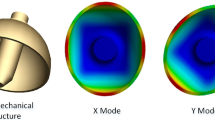Abstract
This paper proposes a procedure to analyze the mechanism of the hemispherical resonator gyro (HRG) drift caused by the acceleration. It is suggested that the deformation of the resonator due to acceleration results in the drift of HRG. The analytical solution to the dynamic model of the resonator is obtained using the Bubnov-Galerkin method. Compared with the numerical solution of finite element simulation, the analytical solution of dynamic modeling is verified to be available. In addition, the relationship between the deformation of the resonator and the HRG drift is established by the harmonic analysis. The HRG drift is approximately linearly increased with the increase of the magnitude of acceleration, and periodically varied with the increase of the phase of acceleration. A drift compensation model is built based on the HRG drift mechanism. The effectiveness of the proposed compensation method is validated through the position tumble experiment using the three-axis turntable. By compensating for the HRG drift, the HRG drift is reduced to one-sixth of its original size, which improves the output precision of the HRG.














Similar content being viewed by others
References
Choi SY, Kim JH (2011) Natural frequency split estimation for inextensional vibration of imperfect hemispherical shell. J Sound Vibr 330:2094–2106
Dai C, Pi D (2017) Parameter auto-selection for hemispherical resonator gyroscope’s long-term prediction model based on cooperative game theory. Knowl-Based Syst 134:105–115
Dai C, Pi D, Fang Z et al (2014) A novel long-term prediction model for hemispherical resonator gyroscope’s drift data. IEEE Sens J 14:1886–1897
Descharles M, Guérard J, Kokabi H et al (2012) Closed-loop compensation of the cross-coupling error in a quartz Coriolis Vibrating Gyro. Sens Actuators A 181:25–32
Fu L, Zhu Y, Wang L et al (2011) A d-optimal multi-position calibration method for dynamically tuned gyroscopes. Chin J Aeronaut 24:210–218
Gray JM, Houlton JP, Gertsch JC et al (2014) Hemispherical micro-resonators from atomic layer deposition. J Micromecha Microeng 24:125028
Hossain ST, William SM, Popov AA (2016) An investigation on thermoelastic damping of high-Q ring resonators. Int J Mech Sci 106:209–219
Kanik M, Bordeenithikasem P, Kim D et al (2015) Metallic glass hemispherical shell resonators. J Microelectromech Syst 24:19–28
Lin Z, Fu M, Deng Z et al (2015) Frequency split elimination method for a solid-state vibratory angular rate gyro with an imperfect axisymmetric-shell resonator. Sensors 15:3204–3223
Liu N, Su Z, Li Q et al (2013) Characterization of the bell-shaped vibratory angular rate gyro. Sensors 13:10123–10150
Ma X, Su Z (2015) Analysis and compensation of mass imperfection effects on 3-D sensitive structure of bell-shaped vibratory gyro. Sens Actuators A 224:14–23
Matveev VA, Basarab MA, Alekin AV (2009) Solid state wave gyro. National Defense Industry Press, Beijing
Nayak J (2011) Fiber-optic gyroscopes: from design to production. Appl Opt 50:152–161
Ni Y, Li H, Huang L (2014) Design and application of quadrature compensation patterns in bulk silicon micro-gyroscopes. Sensors 14:20419–20438
Pan Y, Qu T, Wang D et al (2017) Observation and analysis of the quality factor variation behavior in a monolithic fused silica cylindrical resonator. Sens Actuators A 260:81–89
Rozelle D M (2009) The hemispherical resonator gyro: from wineglass to the plants. In: 19th AAS//AIAA space flight mechanics meeting, pp 1157–1178
Song JW, Song HM, Lee YJ et al (2016) Design of oscillation control loop with coarse-precision mode transition for solid-state resonant gyroscope. IEEE Sens J 16:1730–1742
Sorenson L, Shao P, Ayazi F (2015) Bulk and surface thermoelastic dissipation in micro-hemispherical shell resonators. J Microelectromech Syst 24:486–502
Wang R, Bai B, Feng H et al (2016) Design and fabrication of micro hemispheric shell resonator with annular electrodes. Sensors 16:1991
Wu Y, Pan Y, Wang D et al (2016) The study on temperature characteristics of a monolithic fused silica cylindrical resonator. In: Joint international information technology, mechanical and electronic engineering conference, pp 44–49
Xi X, Wu Y, Wu X et al (2012) Investigation on standing wave vibration of the imperfect resonant shell for cylindrical gyro. Sens Actuators A 179:70–77
Xi X, Wu Y, Wu X et al (2013) Modeling and analysis of the stress effects for trimmed cupped resonator under varying temperature. Sens Actuators A 189:429–440
Xie Y (2013) Research on attitude measurement systems based on hemispherical resonator gyro. PhD Thesis Harbin Institute of Technology, Harbin
Xu Z, Yi G, Qi Z, et al (2016) Structural optimization research on hemispherical resonator gyro based on finite element analysis. In: 35th Chinese control conference, pp 5737–5742
Xu Z, Yi G, Xie Y, et al (2017) Influence of external load on hemispherical resonator gyro feedback control system with state constraints. In: 43rd Annual conference of the IEEE Industrial Electronics Society, pp 6217–6222
Xu Z, Yi G, Wei Z et al (2018a) A dynamic modeling method for resonator of hemispherical resonator gyro. Acta Aeronuatica et Astronautica Sinica 39:221624
Xu Z, Yi G, Xie Y et al (2018b) Influence of acceleration on control system of hemispherical resonator gyro and its suppression method. J Chin Inertial Technol 26:63–68
Yi G, Xie Y, Wang C et al (2014) Modeling of hemispherical resonator gyro resonator deformation under acceleration. In: 26th Chinese control and decision conference, pp 1381–1385
Yu H, Wu W, Wu M et al (2013) Systematic angle random walk estimation of the constant rate biased ring laser gyro. Sensors 13:2750–2762
Zhang Z, Zhang F, Zhang W (2013) Measurement of phase difference for micromachined gyros driven by rotating aircraft. Sensors 13:11051–11068
Author information
Authors and Affiliations
Corresponding author
Additional information
Publisher's Note
Springer Nature remains neutral with regard to jurisdictional claims in published maps and institutional affiliations.
Rights and permissions
About this article
Cite this article
Xu, Z., Yi, G. Acceleration drift mechanism analysis and compensation for hemispherical resonant gyro based on dynamics. Microsyst Technol 25, 3425–3435 (2019). https://doi.org/10.1007/s00542-019-04327-0
Received:
Accepted:
Published:
Issue Date:
DOI: https://doi.org/10.1007/s00542-019-04327-0




